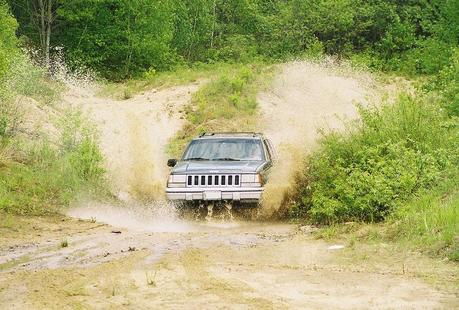
Guest Post; The Golden Rules of Off Road Driving
About the Author: Karla Fetrow is an experienced off-road driver tackling some of the toughest terrain in the U.S in Alaska on a daily basis. Having been raised in the remote areas of Alaska, it is common knowledge to the rural inhabitant that there are places you just can't go without a Jeep, Jeep Wrangler or other sturdy off-road vehicle. Karla frequently writes on behalf of Extreme Terrain.

Practice Makes Perfect
If the most experience you’ve ever had with an off-road is visiting your Uncle Jeremy on a Kansas farm, there are quite a few things you need to know before charting a two hundred mile trek into the wilderness. Obviously, the first order of business is to be prepared. Practice your first off-road adventures on short stretches, where there is nearby help if you need it. Use the buddy system or join an off-road driving club, so you can practice your rock climbing and mud bogging safely. Start with areas that have some rough road; preferably short stretches that have the type of diversity you can expect for long distance off-road driving. Even in flat regions, there are opportunities. Places that have long dry spells tend to develop fissures and cracks in the unpaved surfaces. If the soil is thin, there will be rock outcrops and submerged boulders. These bumpy rides teach you how to maintain control over your vehicle.
Many rivers and creeks have short off-roads that fishermen use to drive down to their favorite hole. The off-road is usually boggy, which will give you experience in driving rough, wet terrain. Two tips about crossing creeks. Never cross a creek that does not have tire tracks on the other side. This means the creek is too deep or the currents too strong for crossing. Once you begin crossing a creek, don't stop. The chances are you won't make it to the other side if you slow down or stop your momentum.
Before starting a mountain adventure, utilize a few two-lane mountain roads. These roads are usually steeply graded, with a lot of sharp turns and dips. They also supply a number of unpaved off-roads where you can get some practice in without being too far away from civilization.
Okay, you’ve done all that. You’re ready to rock and roll, and want to head out to the wild blue yonder. Check your vehicle first. Make sure your brakes are good, your battery is in top condition, all lights are in proper working order, the suspension is tight and not flopping anywhere and your shocks are not going to leave you pounding bottom. Do a test drive and listen for any odd noises or vibrations.
Your Jeep is Ready; Are You?
The number one golden rule to remember when planning a long distance off-road trip is gas stations and even houses are going to be far apart. If you break down, you are stranded until someone comes along to help; which could be hours. Pack at least two gallons of fresh water; one for you and one in case your Jeep or Jeep Wrangler over-heats. Carry an emergency medical kit. The “auto kit” ones are great because they are compact and have plenty of supplies for just about any emergency situation. Bring an assortment of dried and quick energy foods; nuts, candy bars, energy bars, crackers, jerky, cheese spread are all good because they won’t take up much space or preparation. Bring along a blanket, extra sweater or jacket and rain gear. When we make plans for off-road driving that involves more than a fifty mile trip, we also bring along a small bundle of firewood. If you’re stranded, or end up staying the night on an off-road, there is no guarantee you’ll find dry wood or appropriate brush wood for starting a camp fire. Carry along an ax in case you need to do a little chopping, and a compact shovel. Make sure your jack works properly, your spare tire is good, you have jumping cables and a small mechanics tool kit. Leave nothing up to chance.
Batten everything down. This includes all your supplies, your tool box, water jugs and even your battery. Even gravel roads often times has “washboard”. While you are shaking and rattling, so is everything else and they can start sliding all over your Jeep if they aren’t secured properly. You should also carry along an extra container of gasoline, and it should be battened down tightest of all. Make sure the lid is tight, with absolutely no seepage.
Those Off-Road Citizens
Most off-road drivers are extremely polite. Don’t be surprised at perfect strangers that smile and wave as they pass by. On roads that have room for only one car to pass, back up for the person coming toward you on the left until you find a safe spot to pull over. Occasionally, especially on steep, twisting mountain passes, this can be hard to do. If you have the right-of way, but know there isn’t an immediate pull-off point for the other driver, and you’ve just passed a prime spot, indicate you’ll do the backing up. Off road drivers don’t like bullies, even when they’re in the right. The protocol is “safety first”.
If you see an off road driver in trouble, stop to help. It’s not only the polite thing to do; there is a lot of practicality involved. You never know when you’ll be in the same position, and there’s no need to build hostile attitudes among other off road drivers. Plus, that person could be a local inhabitant, willing to share some nice off-road secrets while you’re helping him get his four wheel drive back on the road again.
On two-lane country roads, there is usually a small general store or mom and pop place near the entrance to popular off-roads. If the off road is especially long and has inhabitants, you might find one along the way. Drop in. Have a soda. Talk to the proprietor and the customers. They can give you pertinent information such as the best route to take, road conditions and acceptable camping spots.
Do not enter off-roads clearly or not so clearly marked as private property, no matter how remote the area. If the property is marked, they mean business, and do not welcome sight seeing tourists. Never throw your garbage out on an off-road. Wait until you re-enter civilization and find an appropriate dumpster. Your trip will be more enjoyable and the back country citizens will be more receptive if you follow a few rules of polite etiquette.
If You Get Stuck
The smartest tool on a back road is a winch, but maybe you feel you just couldn’t afford one. You’ve already sunk a lot of money into your vehicle and your planned off-road vacation. If you bogged down, you’re just going to have to get unstuck the old fashioned way; pushing and heaving.
You may have noticed that a lot of back country drivers don’t have winches on their vehicles. This is because they’ve learned a few tricks over the years. One of the first rules if you get stuck in either snow or mud is not to spin your tires. You will not get out of the situation by gunning to the floorboard. Try rocking gently back and then forward. If doing this a few times doesn’t help, try looking for some kind of matting to fill in the hole. If you see a gravel patch nearby, fill in the hole with gravel (now you know why you need a shovel). Put it directly behind the stuck tire. You’ll have more traction back up than trying to move forward. If there’s no gravel, hack down a few branches and place them in the hole. This also works in snow.
In snow conditions, most back road drivers carry a bag of sand or kitty litter just for this emergency. If your four wheel drive is a truck, it also helps create better balance in the back end. By spreading sand or kitty litter in the hole, as well as in front and behind all your tires, you should have enough traction to pull out.
What if you’re in snow and one tire slips off the side of the road? You’re buried and it’s going to take two hours to dig your way out! There is one little trick that doesn’t get a high approval rating on the proper-way-to-get-out-of-a-ditch index, but it works. Jack up the side of the vehicle where the wheel is buried, but not too high. Just enough to lift the wheel from the snow. Push the jacked up side toward the road until the jack slips. Sometimes, it takes a couple of efforts, but eventually the wheel will be clear.
Another hint on winter driving. Just because you have four-wheel drive, does not mean you can whip around corners at sixty miles an hour in icy conditions. Because all four wheels are turning, you have a good chance of rolling. Every winter, we see more four wheel drives that take a roll on sharp corners during icy road conditions than we do two wheel drives, because they were going too fast. Slow down for the sharp curves. Your Jeep may cling to the road like a champ, but ice is unforgiving.

